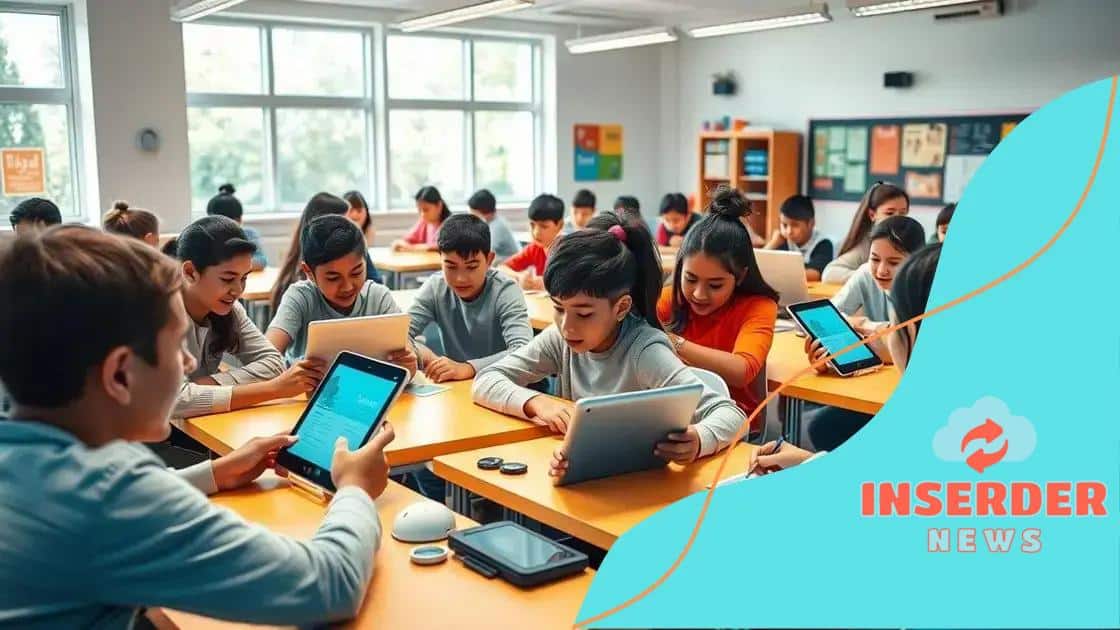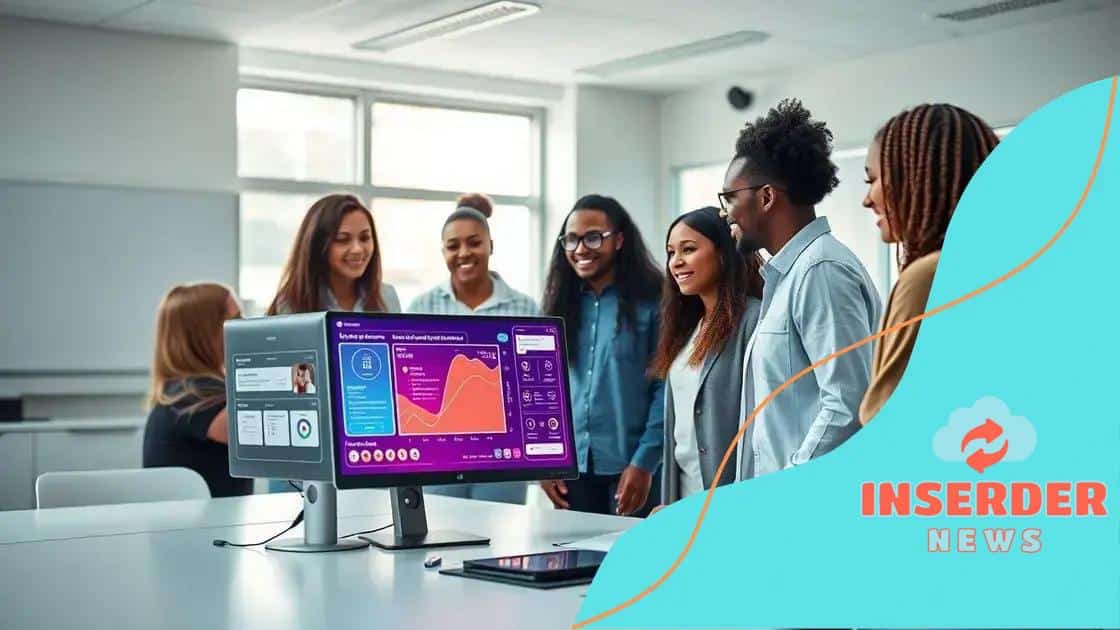Using AI tools to track and improve student performance

Using AI tools to track and improve student performance enhances personalized learning, identifies strengths and weaknesses, and fosters a more responsive educational environment through data-driven insights.
Using AI tools to track and improve student performance is becoming a game-changer in education. Have you ever wondered how technology could provide insights into students’ learning journeys? Let’s dive into how these tools work and their potential impact.
Understanding AI tools in education
Understanding AI tools in education is crucial for enhancing learning experiences. These tools can analyze student performance and tailor educational approaches to individual needs. By leveraging technology, schools can create a more personalized learning environment that benefits both teachers and students.
Types of AI Tools
There are several types of AI tools used in education today:
- Learning Management Systems (LMS) that utilize AI for personalized content delivery.
- Assessment tools that provide insights into student understanding and progress.
- Chatbots that assist with student inquiries and administrative tasks.
- Data analytics tools that help educators track performance over time.
Each type of tool serves a different purpose, but they all contribute to a comprehensive understanding of student needs. For instance, learning management systems can help deliver content in a way that adjusts based on how well a student is grasping the material. This adaptive learning approach can be incredibly effective for varying levels of understanding.
Benefits of AI Integration
Integrating AI tools into education offers multiple benefits. First, they can provide valuable data on student performance. This data helps teachers identify areas where students may be struggling. Additionally, AI tools can save teachers time on administrative tasks, allowing them to devote more energy to teaching.
Furthermore, AI can enhance student engagement by offering interactive learning experiences. Imagine students participating in lessons that adapt in real-time to their responses. This technology not only makes learning more enjoyable but also fosters a deeper understanding of challenging concepts.
Benefits of tracking student performance with AI
Tracking student performance with AI offers significant advantages that can transform educational practices. Utilizing AI can reveal insights that traditional methods may overlook. For example, schools can gain a deeper understanding of how each student learns and what challenges they encounter.
Identifying Learning Gaps
One of the key benefits is the ability to pinpoint learning gaps. AI tools analyze data to determine where students struggle. This allows teachers to adjust lessons and provide targeted support. When teachers know exactly where each student needs help, they can tailor their teaching methods for better outcomes.
- Personalized Learning: Each student can receive materials suited to their unique needs.
- More Engaging Lessons: Teachers can create activities that resonate with individual learning styles.
- Real-Time Feedback: Students can get immediate input on their performance, enhancing motivation.
Additionally, tracking with AI provides valuable data over time. Schools can see trends in performance, helping to inform future curricula. When educators understand which programs yield the best results, they can focus on methods that work. This continuous assessment encourages a cycle of improvement.
Enhancing Teacher Efficiency
Moreover, AI significantly enhances teacher efficiency. With less time spent on administrative tasks, educators can devote more time to what matters: teaching. AI processes large sets of information quickly, allowing teachers to concentrate on personalized instruction rather than data compilation. Less manual grading and data entry means teachers can enjoy a healthier work-life balance.
Ultimately, tracking student performance with AI not only supports students in achieving their academic goals, but also empowers teachers to be more effective. The result is a more dynamic learning environment and improved educational outcomes for all.
How to implement AI tools in schools

Implementing AI tools in schools can seem daunting, but it can lead to significant improvements in education. The process can be simplified into several actionable steps. First, it’s essential to assess the needs and goals of the school. Understanding what specific challenges the school faces will help identify the right AI solutions.
Step 1: Assess Needs and Set Goals
Schools should start by examining their current educational practices. What areas need improvement? Gathering input from teachers, students, and parents can provide valuable perspectives. Setting clear goals helps in selecting the most appropriate tools.
- Identify challenges: What issues do teachers face in the classroom?
- Gather feedback: What do students feel they need to succeed?
- Establish objectives: What do we want to achieve with AI?
Once needs are identified, the next step involves thorough research on different AI tools that are available. Several options cater to various aspects of education, such as personalized learning, assessment, and administrative tasks. Evaluating these tools based on effectiveness and usability is crucial.
Step 2: Choose the Right Tools
Collaboration among educators is vital when selecting AI tools. Teachers can share insights about which platforms work well for them. It’s also helpful to pilot a few tools with a small group of students. Gathering data during this trial period can inform decisions about wider implementation.
In addition to selecting tools, investing in teacher training is essential. When teachers are well-prepared, they can maximize the potential of AI in their classrooms. Training should focus on how to integrate AI into existing curricula effectively.
Step 3: Monitor and Evaluate
After implementation, it’s important to continuously monitor the effectiveness of the AI tools. Schools should regularly evaluate whether they are meeting the set goals and adjust strategies as needed. Feedback from students and teachers will aid in this assessment process.
With the right planning and support, integrating AI tools into schools can enhance learning experiences. The key is to remain flexible and responsive to the needs of both students and teachers, ensuring that AI serves as a beneficial resource.
Challenges in using AI for student assessment
Using AI for student assessment brings several challenges despite its potential benefits. Understanding these challenges is essential for educators and administrators. One significant issue is data privacy. Schools must ensure that the data collected from students is secure and used responsibly. Many parents are concerned about how their children’s data is stored and shared.
Data Privacy Concerns
Protecting student information is vital. Schools need to implement strong data protection policies. They should inform parents and students about how their data will be used and the measures taken to protect it.
- Compliance with regulations: Schools must follow laws regarding data privacy.
- Transparent practices: Clear communication about data usage builds trust.
- Secure systems: Investing in security software helps safeguard data.
Another challenge is the potential for bias in AI algorithms. If an AI system is trained on biased data, it may produce unfair assessments. This can affect student outcomes and reinforce existing inequalities. To counteract this, schools must use diverse datasets for training AI tools.
Bias and Fairness
Understanding the implications of bias is crucial as it can determine how students are evaluated. Continuous monitoring can help identify and address biases in AI assessments. Regular updates to the algorithm can ensure fairness in evaluations.
Moreover, lack of teacher training can hinder effective implementation. Teachers need to know how AI systems work to use them successfully in their assessments. Proper training enables educators to interpret AI results accurately and apply them to their teaching strategies.
Teacher Training
Providing professional development is key. Schools should offer training sessions that help teachers understand AI tools and leverage them in the classroom. Resources and support materials can also guide teachers in their implementation efforts.
Addressing these challenges requires careful planning and commitment. With the right strategies, schools can effectively integrate AI for student assessment while overcoming obstacles.
Future of AI in student performance tracking
The future of AI in student performance tracking holds great promise as technology continues to advance. Schools are now looking at innovative ways to enhance learning through data-driven insights. With AI, educators can expect to see more personalized learning experiences that adapt to each student’s needs.
Enhanced Personalization
In the coming years, AI tools will likely provide increasingly sophisticated personalization. This means lessons and resources will be tailored to match individual learning styles and paces. By analyzing data, AI can identify specific areas where students excel or struggle, allowing for targeted interventions.
- Adaptive Learning Platforms: These platforms will change content in real-time based on student responses.
- Customized Feedback: Students will receive precise feedback suited to their learning progress.
- Focus on Strengths: AI will help highlight what students do well, promoting confidence.
Another exciting development is the integration of predictive analytics. AI can use historical data to forecast a student’s potential future performance. This information allows educators to proactively address challenges before they become significant issues.
Predictive Analytics
By leveraging predictive analytics, schools can develop strategies to keep students on track. This proactive approach ensures that no student falls behind. Educators can adjust practices based on insights provided by AI, creating a responsive learning environment.
Collaboration between AI tools and educators will also become more integrated. Teachers will not only rely on AI for assessments but will work alongside these tools to enhance instruction. Making data collaborative will enable more insightful teaching strategies.
Collaborative Teaching Practices
As AI continues to evolve, it is important for teachers to embrace its capabilities. Professional development focused on AI literacy will be crucial for educators to maximize the benefits. A better understanding of how to use AI tools effectively will lead to improved student outcomes.
The future of AI in student performance tracking is one where technology and education work hand in hand to provide high-quality learning experiences. With ongoing advancements, students can look forward to a more engaging, tailored educational landscape that meets their unique needs.
In summary, the integration of AI in education can significantly enhance the way student performance is tracked. By providing personalized learning experiences, AI tools help identify learning gaps and strengths. While challenges such as data privacy and teacher training exist, the future looks promising. Schools can leverage AI to create a responsive learning environment where both students and educators thrive. Emphasizing collaboration and continuous improvement, educators can harness AI’s potential to foster student success.
FAQ – Questions about AI in Student Performance Tracking
How can AI personalize learning for students?
AI can analyze individual student data and adapt lessons based on their unique learning styles, ensuring a more tailored educational experience.
What are the privacy concerns related to AI in schools?
Data privacy is a major concern as schools must protect student information and ensure it is used responsibly and securely.
How can teachers effectively implement AI tools?
Teachers should receive training on how to use AI tools, allowing them to interpret data well and integrate these tools into their teaching strategies.
What future benefits can we expect from AI in education?
AI is expected to enhance student performance tracking, provide real-time insights, and foster more collaborative learning environments.






